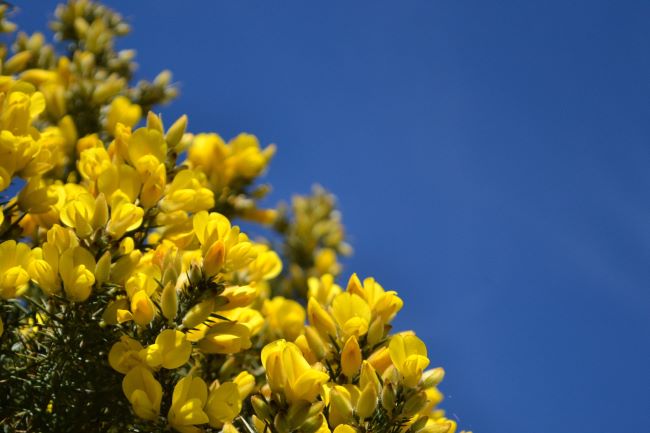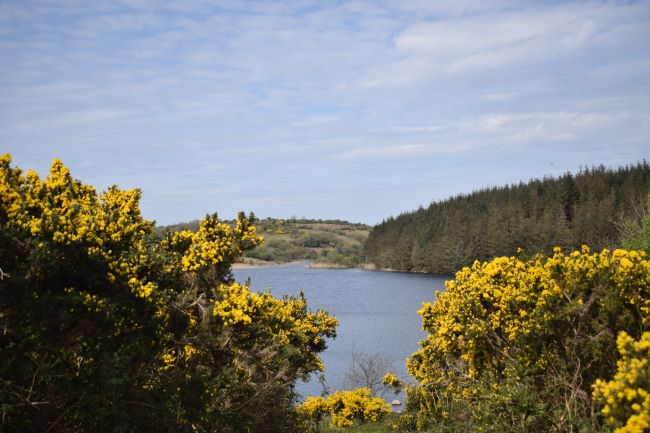Gorse Wine
The golden flowers of gorse are an ever present part of the summer in peaty moorland. If you are lucky enough to live near a gorse field and have the patience to pick a LOT of flowers then you can make a delicious golden wine.
Make in Early-mid spring
Difficulty: Medium

Ingredients
This will make 1 gallon (4 litres) of wine. To make double or half the wine, just use double or half the amount of every ingredient.
- 4 litres (10 pints) gorse flowers
- 4.5 litres (1 gallon) water
- 1kg (2 lbs) sugar
- 2 lemons, zest and juice
- 5g sachet of champagne or wine yeast
You can get away without so many flowers if the time or thorns got the better of you, in which case simmer for longer in the first step of the recipe.
Equipment
You will need
- Fermenting Bucket
- Demijohn with an airlock
- Sieve or straining bag
- Plastic funnel
- Syphon tube
- Wine bottles for the final product (or more plastic bottles)
Remember to sterilise all equipment with hot water before using it by swirling with boiling water
Method
The Flowers
Collect your gorse flowers, remember to avoid any that have been contaminated with animal waste (so avoid the plants at dog height next to a path for example). Always forage responsibly and leave some flowers for the bees
Gorse bushes are spiky so use gloves and long sleeves!
Wash the petals and spread them out on a clean surface or paper to dry, and to let any bugs find their way back into the wild
The Brew
Put the flowers and water in a large pan and bring the water to a simmer
Simmer for 2-6 hours. You really can’t overdo this part because a long slow simmer will extract the maximum flavour from the flowers, but if you want to finish within an afternoon then 2 hours will do a job
Turn off the heat and pour the sugar into the saucepan, stirring until it is dissolved. If it cools too quickly to dissolve the sugar then give it a quick blast of heat to help it along but don’t bring back to the simmer
If you have the time then leave the sugar gorse to stand for another 2-3 hours
Sterilise the fermenting bucket and strain the liquid into it, discarding the flowers and any sediment
Allow the water to cool
Add the sachet of yeast to the bucket and give the mixture a stir
Cover the bucket and leave it for 4-6 days, stirring once or twice a day with a sterilised spoon
Straining and Bottling
After 4-6 days the next step is to transfer to a demijohn to let the wine ferment in a more controlled environment
Remember to sterilise everything as usual!
It might be easier to go in stages and use a sieve or straining bag to strain the mixture into a sterilised pan or bucket, and then transfer from there into a demijohn. Use large screw-top plastic bottles if you don’t have a demijohn
The demijohn’s bubble trap will let off any excess pressure
If using bottles, you will need to loosen the lids to let off some gas when you see the bottles bulging too much
You don’t want a fizzy wine with this recipe but you can move to the next step when it has either fully finished fermenting or has a tiny bit of fizz left
The flowers will have left some sediment in the demijohn, and the wine will still be cloudy. Let’s fix that.
Rack off into a second demijohn (or into the same one via a sterilised bucket)
Leave it for until it is clear, likly to be 2-3 months
When it is clear, syphon into clean sterilised bottles and store for a year before drinking. This wine benefits massively from this time to mature
Enjoy!
Troubleshooting
My Bottles Exploded
This is a common complaint and there is a chance it will happen sooner or later if you use glass bottles so do be careful. There are a few ways to avoid explosions:
- Let off some pressure every day - this requires a decent amount of attention to uncap the lid once a day and let some of the air fssss out. Don't release it all or you will get flat (but still very drinkable) wine rather than fizz
- Use plastic bottles! They may still burst if you don't watch them, but you will get some warning to release some of the pressure if they start to bulge
- Use a demijohn with an airlock before bottling - this will release the gas but make sure you don't leave it too long or the wine will become a lot stronger and flat with no extra bubbles when the higher alcohol content kills the yeast. Transfer it to bottles once the bubbling slows down, but not when it's completely stopped because you still want some natural fizz in there. If you do wait a bit too long, try adding a little more sugar and champagne yeast to get things moving again
- Stick it in the fridge - the cool temperatures will slow down fermentation so you will be safe until you want to drink it. You may see the same thing if you store the fermenting bin in a cool place; the lower temperature means the yeast aren't so keen to turn the sugar to alcohol and fizz so you will get a longer fermentation time
The Wine Is Bitter
The most likely causes are either some green bits crept in to the brew or you didn't sterilise the equipment at the start. Unfortunately there is not much you can do about this other than try to add more sugar water so the sweetness offsets the bitter flavour, or use the wine in a cocktail. The best thing to do is to head out with your sturdy gloves and try again
I Don't Have a Demijohn
If you don't have a demijohn then leave the brew in the fermenting bucket for 5-7 days which should give enough time for the main rush of fermentation to die down, and then bottle it. If you aren't sure then "burp" a bottle every day for the first week to let some gas out. If it seems very fizzy then carefully burp a little gas from the other bottles. This is a bit of an art - too much burping and you end up with a flat beer
If you are still worried then go for a plastic bottle instead of glass. That way, the plastic will bulge when it's ready to burp some gas. And worst case you end up with a popped lid instead of broken glass
Questions and Answers

How Do I Identify A Gorse Bush?
Gorse flowers bloom on the spiky-leaved gorse bush (ulex europaeus). This evergreen shrub grows up to 2 metres (6 feet) high and tends to grow in wide and dense clumps. The bright yellow pea-like flowers cover the bushes in early to mid spring, giving off a coconut scent.
If in doubt, take a look in the library for a guide or read through the Woodland Trust’s quick guide to the gorse bush.
Where can I find gorse?
Gorse grows best in dry, sandy soils and will happily grow in acidic soil so you will find it near the beach, on open moorland, or grassland near the coast. It grows through most of the UK and Ireland. It is native to Western Europe and was introduced to western and north-eastern USA with some states listing it as a noxious weed. It was also introduced to Australia where it grows mostly in the South-East and Tasmania, and to New Zealand as well where it grows throughout the country.
When should I forage for gorse?
Gorse flowers almost the whole year round, but its best and most fragrant flowers come in mid to late spring. So harvest it in April-May in the northern hemisphere, or September-October in the southern hemisphere.
What is the difference between gorse and broom?
The broom (cytisus scoparius) looks very similar to gorse but shouldn't be used to produce wine. The flowers have been used medicinally as a diuretic but please do your own research before considering that use. Gorse and broom both like the same habitats and produce bright yellow flowers. The biggest difference is in the shape of the bush. Gorse is very spiky, very dense and evergreen. Broom has long, flexible, smooth stems with no spikes and forms a less dense and more open, spreading shape.
